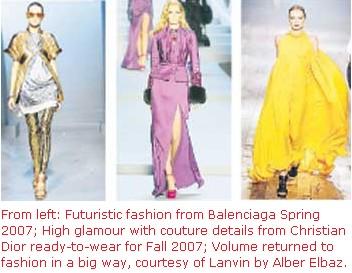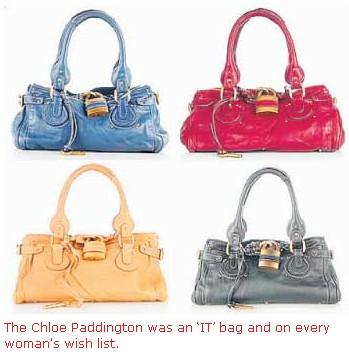 CHEONG PHIN reflects on a decade of fashion.
CHEONG PHIN reflects on a decade of fashion.
THE year marks the end of the first decade in the third millennium.
In the run up to the New Year, we pause to reflect on the past 10 years of fashion changes and their influence on the way we breathe fashion, buy fashion and wear fashion in the Noughties.
The end of the nineties saw fashion moving into an age of realism and pluralism whereby there was no single dominating trend, but a basketful of trends for everyone.
This pattern, more or less, sets the fashion tone for the new millennium, resulting in a surge of designers, affordable fashion labels flooding the fashion industry and the rise of the “globalisation of fashion” aided by the rapid technological advance in transfer of electronic information across the world.
THE END OF MINIMALISM
Not only has the fashion mood gone less minimal in the new millennium, the fashion industry was gearing up for the next generation of consumers (a maturing generation X and a fresh generation Y) on a global scale.
Driven by social and economic trends, fashion was more about satisfying the global demand for luxury and less of inventing strong, directional looks.
There was a look suited for everyone. From floaty tea dresses, satin sportswear, ethnic tops, swing dresses, midi skirts, cocoon skirts, one-shoulder dresses, jumpsuits, bandage mini dresses to skinny jeans, harem pants and leggings, designers were instead inspired by retro looks of 40s, 60s, 70s, 80s and reinterpreted them with new ways of construction in innovative fabrics season after season.
In short, fashion in the new millennium was not about intergalactic looks but a remix of glamour, romance, boho-chic, ethnic luxe, jet-set resort, utility chic, eco-chic, military warrior, semi-couture and glam-rock.
Well, a brush with futuristic looks happened in Spring/Summer 2007 when designers went crazy about anything metallic.
Nicolas Ghesquiere at Balenciaga in Paris delivered an astonishing collection of heavily-sculpted metallic pantsuits and the most expensive gleaming gold metal robot leggings while MaxMara showed different ways to tuck, drape and wrap a metallic sack dress in shiny wet-look linen and metallic lurex.
THE INTERNATIONAL DEVELOPMENT OF FASHION BRANDS
The battle of the big fashion brands that started in the late nineties continued into new decade.
In 2001, the LVMH Group, world's largest luxury goods conglomerate, bought over Donna Karan New York (DKNY) and Emilio Pucci while in 2004 acquired more interests to become the sole majority shareholder of FENDI — international Italian brand of bags and fur.
Main rival Gucci Group-PPR, on the other hand, acquired younger edgier desirable brands with a strong potential (Balenciaga, Alexander McQueen, Stella McCartney) in 2001 to add onto their portfolio that includes premier brands like Gucci, Bottega Veneta and YSL Rive Gauche.

Together with other international fashion players, they embarked on a global expansion strategy by setting up some of their largest stores in the rapidly growing China, Middle East and Russian markets as well as other emerging Asian markets.
It brought easy access to international labels across the world and paved the way for vast development in the retail landscape of many countries. For example, in Kuala Lumpur alone, at least five new mega shopping malls (The Gardens Mall and Pavilion) have sprung up this decade to whet the appetite for international fashion brands that were once only available overseas.
NEW WAYS OF BUYING FASHION
“Fast fashion” became a buzz word in UK clothing during the late nineties when vertically integrated Spanish retail chains Mango and Zara made their debut with affordable fashion looks that mirrored the latest catwalk trends.
The quick-fashion-fix-at-budget-friendly-prices trend blossomed in the Noughties with global expansion of these two Spanish chains as well as a host of other retail chains including TopShop, Primark and Hennes & Mauritz (H&M).
It revolutionised the shopping culture for everyone this decade and big-time designers acknowledge the change by succumbing to collaborations with these commercial retail chains to produce one-off capsule collections to tap onto their mass market.
With the progress of information technology, online shopping became a widely accepted way of shopping this decade as consumers were in favour of an easier, convenient and instantly accessible mode of buying into the latest fashion.
Today, nearly every fashion brand has an online shopping cart in their official website or Facebook fan club to compete with other specialised online shopping sites like www.net-a-porter.com which offers a wide range of designers clothing and accessories.
CELEBRITY FASHION CULTURE
When the supermodel star power fizzled out in the late nineties, Hollywood celebrities filled in the void, appearing regularly on fashion magazine covers such as Vogue which, according to editor-in-chief Anna Wintour, evidently helps magazines fly off the shelves.
This marriage of celebrity and fashion augmented "celebrity culture" in the first decade of 2000 with more fashion covers, product endorsements and designers competing (with the help of stylists) to dress them during “red carpet” events for a global publicity money cannot buy. Best example was the instant shot to stardom for unknown Lebanese designer Elie Saab who dressed Oscar winner Halle Berry in 2002.
Sex and the City — a TV series based on four individualistic women in New York City which began in 1998 became a cultural and fashion phenomenon this decade, influencing women across the globe to indulge in free-spending on fashion labels, nameplate necklaces, corsages, (Manolo) Blahniks and (Jimmy) Choos.
Although the series ended in 2004, the impact was so unforgettable that a movie version was inevitably released in 2008, with a sequel being filmed now.
THE CONQUER OF ACCESSORIES
If anything was to be noted in fashion this decade, it has to be the conquering role of accessories in every woman's wardrobe.
In the mid Noughties, handbags outsold ready-to-wear and gave rise to the “IT” handbag mania that almost dethroned designer clothes. Bags fit women of all sizes, have better fashion mileage and were treated affectionately like pets with names attached to them.
The Fendi Spy, Mulberry Roxanne and Chloe Paddington, to name a few, come to mind. Who could forget Anya Hindmarch's “I’m Not a Plastic Bag" cotton tote that was part of the anti-plastic bag movement that reminded us of saving the environment.
The “IT” bag mania lost its steam about two years ago and quickly taking its place in fashion were designer shoes, giving rise to the prominence of past shoe designers such as Giuseppe Zanotti, Jimmy Choo and new designers like Pierre Hardy and Christian Louboutin whose signature red lacquered sole remains one of the decade's important fashion trademarks.
Faux or real, big, bold jewellery made a comeback from the 80s as well as the waist-cinching belt in the second half of the decade.
THE FASHION DESIGNERS — PAST, PRESENT and FUTURE
The decade witnessed the sad passing of two fashion greats. Gianfranco Ferre, the bearded “architect of fashion” died in June 2007 after suffering a brain haemorrhage and Yves Saint Laurent in June 2008 from illness, after having only taken his final bow from fashion in 2002.
For over 40 years Valentino Garavani, known to all simply as Valentino, has been one of the most prominent names in fashion, creating some of the world's most elegant eveningwear and classic designs.
He surprised the fashion world with an announcement of his retirement in late 2007 after severe changes in shareholding interests.
Similarly, in April 2004, Tom Ford, the designer who brought sexy back to fashion and catapulted Gucci to new heights, parted with the brand for the same reasons.
He subsequently set up his own label and directed a movie entitled A Single Man this year.
In 2003, Calvin Klein who revolutionised fashion with designer jeans and minimalist-chic looks, sold his company to Philips-Van Heusen and retired from the industry the same year.
The tireless Karl Lagerfeld, who is the creative head of Chanel, Fendi and his eponymous label, still amazes the fashion world with his reinvented looks while the other surviving fashion great Giorgio Armani is succumbing to ill health, but remains as designer of his fashion empire.
After an era of successful brand revival by Galliano, Ford, Jacobs and McQueen in the nineties, established old brands soon realised the need to pump new life into their designs to appeal to a younger consumer base.
Notable recruitments include the talented Alber Elbaz for Lanvin of Paris; Christopher Bailey for Burberry; Stuart Vevers for Loewe; Phoebe Philo for Chloe and now Celine; Raf Simons for Jil Sander and Christophe Decarnin for Balmain.
Across the Atlantic, a surge of young Asian American designers was making waves in the world of contemporary fashion in the mid Noughties. Names such as Thakoon, Peter Som, Jason Wu, Phillip Lim and award winners Doo-Ri Chung and Alexander Wang are creating styles all their own and proving to be a tough challenge for European designers now and the next decade.

THE RECESSION
In 2008, the severe credit crunch that burst in America sent shock waves across the globe and the fashion industry was not spared. Consumer spending dipped and resulted in shocking bankruptcies of international fashion brands Escada, Yohji Yamamoto and Christian Lacroix.
On a lighter note, the global meltdown also gave rise to new fashion catch-phrases like “recessionistas” to describe the fashion players setting out to weather the recession, “chiconomics”, “frugal chic” and “recession-proof dressing”.





